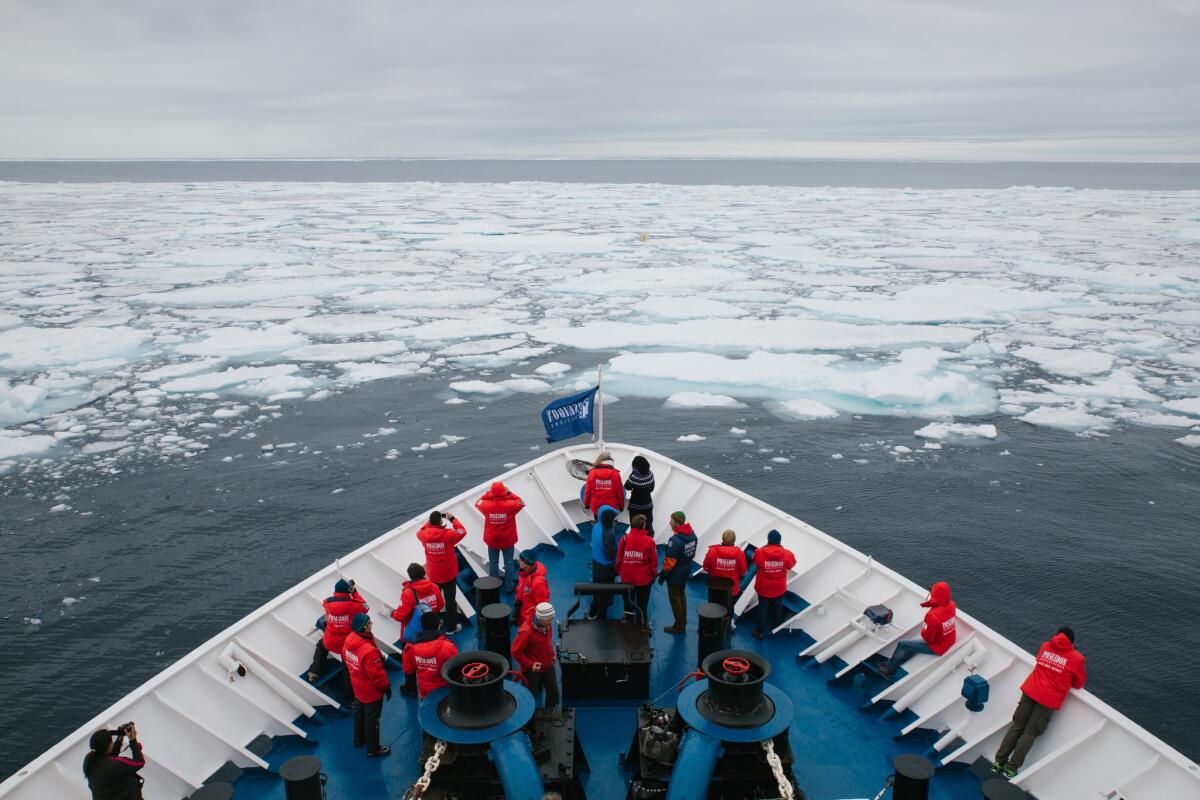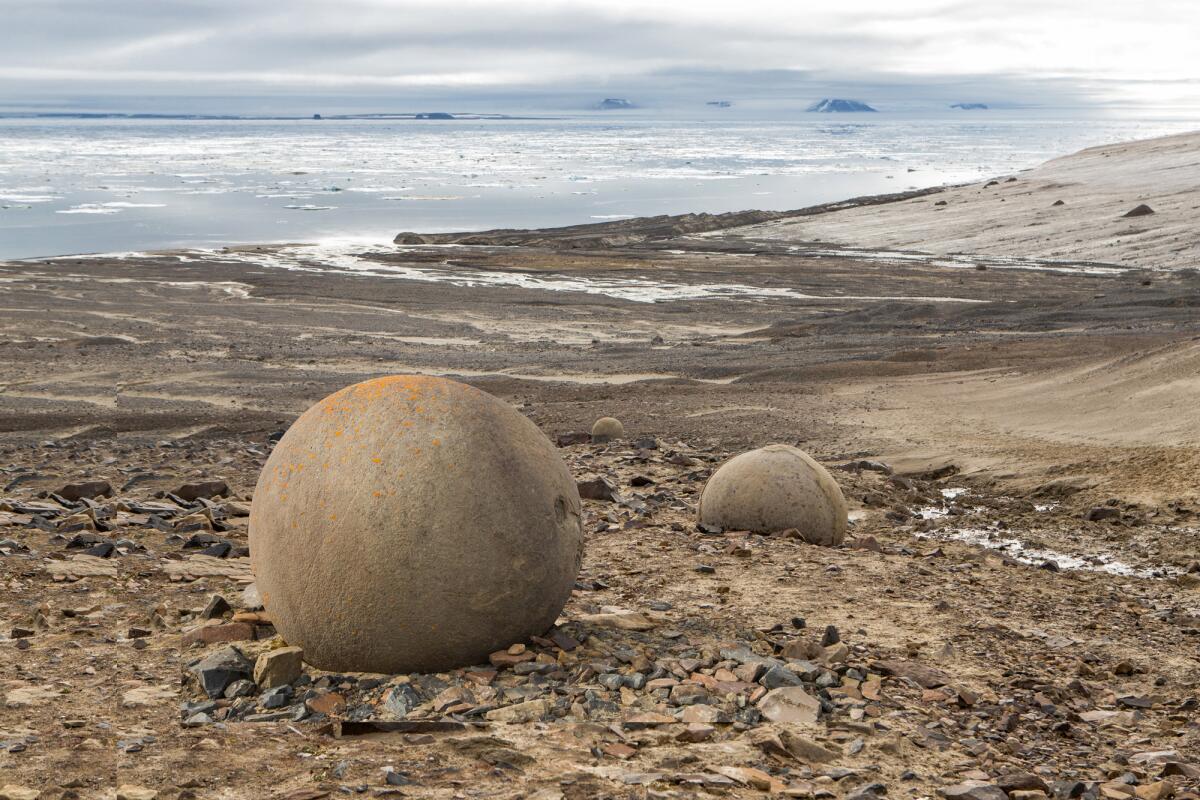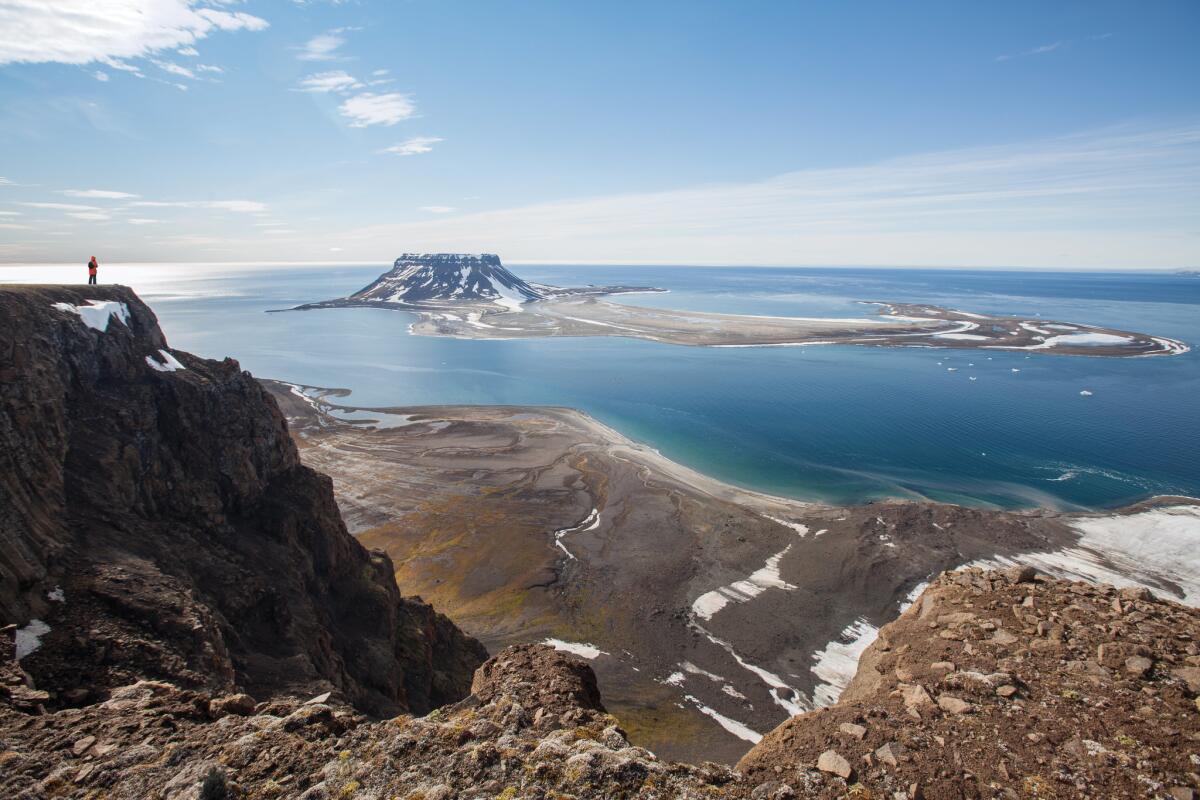What to know before chasing polar bears in the Russian high Arctic
- Share via
This isn’t the Russia you’ve heard about on cable news. You can't fake the beauty of this place a few hundred miles from the North Pole.
I watched as the rays of the midnight sun caught a giant white bear curled up on an ice floe. A tiny fur ball playfully licked its mom’s snout. The mother bear, waking up grumpy, splashed into the frigid water as the 297-foot ship on which I was a passenger zigzagged through the Barents Sea.
This is Franz Josef Land, the northernmost point in Russia where neither people nor politics exists. Besides the handful of park rangers stationed on these islands, you’ll find no permanent inhabitants and few structures. This is true wilderness.
I was aboard Poseidon Expeditions’ 114-passenger Sea Spirit for 15 days in the high Arctic, a place I’ve long been curious about. As I stared at a gray sky that seemed to melt into an equally opaque sea, I saw all manner of floating ice forms that looked like sculptures calved from ancient glaciers.
These surroundings felt otherworldly, yet life was everywhere, even if hidden by fog or freezing seas.
Just off Alexandra Land, the westernmost of this 192-island archipelago, I watched polar bears paddle until the waves of the Cambridge Bay swallowed them.
A challenge to visit

The natural magic is so real in Franz Josef Land that propaganda couldn’t do it justice. The archipelago, part of the Russian Arctic National Park, is the country’s largest protected area and the region’s largest marine reserve.
A National Geographic moment quickly gave way to howling wind and stinging flurries. I could easily imagine how hellish life had been here before central heating, down jackets, refrigerated food and modern navigation.
In 1926 Russia annexed the archipelago, which an Austro-Hungarian North Pole expedition had discovered in the late 19th century.
It was a strategic location for Soviet bases during the Cold War, and little has changed since 1994 when FJL became a zakaznik, or nature reserve. No infrastructure has been installed, but some decrepit bases have been rebuilt.
About 1,000 tourists visit annually, according to the Kremlin, which claims to want ecotourism but is conservative with permits and development.
There is nowhere to stay, which makes a visit by ship ideal, and you must be on an icebreaker most of the year. (The Sea Spirit is ice class, good enough in summer.)
These challenges keep people away but also keep the place pristine. Aside from polar bears, there are 150 species of moss, 167 of lichen and 50 of flowering plants, plus nesting seabirds and pods of walruses and bowhead and humpback whales.
Have a ball
On Champ Island, a highlight, I saw stone spheres that reinforced the otherworldly feeling. Some were big enough to climb on, others palm-sized as though they were sent by an angry god eager to play some form of celestial soccer.
The spheres were everywhere, some so flawless I wondered how they got here.

Geologists say they were molded by centuries of melting glaciers. I spent a day dancing among them, snapping selfies in the 24-hour daylight as Russian rangers, wary of curious bears, looked on with automatic weapons.
Being close to wildlife is special, especially in this point-and-click digital age, but the cosmic stones have stayed with me.
I knew they were natural, I knew their origin, yet their singularity, scattered for eternity on an icy beach, punctuated how end of the world this land felt.
Few humans, lots of bears
Some claim there are more polar bears in FJL than anywhere else.
“Russia revoked permission for the joint Norway-Russia polar bear survey a few years back, so there's no meaningful new estimate,” said Andrew Derocher, a professor of biological studies at the University of Alberta, Canada, who has spent three decades studying bears.
He said the “bears in western Russian are highly polluted,” referring to polychlorinated biphenyls, or PCBs. The chemical was banned in the 1970s but was trapped in the ice, then released as it melted. It accumulates in bears when they eat seals, which could affect fertility.
Yet the mother and cub I watched earlier looked healthy. Fat even. It shows how complicated and confusing this landscape can be to an outsider.
Some of FJL’s islands have wildlife that would rival the contents of Noah’s ark. I saw thousands of guillemots, birds in the auk family, perched on Rubini Rock on Hooker Island, while other isles had nothing. Eighty-five percent are glaciated, after all, with islets and floes galore. I lost track of how many islands I saw.
On Alexandra Land, a base and immigration stop called Nagurskoye reminded me of the frozen outpost in John Carpenter’s “The Thing.”
I handed my passport to a young ranger. He scanned my picture, eyes lingering. I felt sweaty under my parka.
“Same,” he said, pointing. “Same birthday.”
He smiled, stamped, handed back the passport, then bowed oddly. I lowered my head, mumbled “Spasiba” and headed back to the Zodiac and my world.
If you go

The best way to Svalbard, Norway
SAS offers flights to Longyearbyen, Svalbard, a mining settlement on an unincorporated Norwegian island where passengers board the Sea Spirit.
A Russian visa is required; the paperwork can take weeks, but an expediting service can get you a visa more quickly.
Poseidon Expeditions, (347) 801-2610. Poseidon will offer two cruises to Franz Josef Land In 2019; departures are Aug. 1 and 13. Rates start at $8,816 for 14 days.
Some expedition ships are converted freighters, which means floor plans and public spaces are an afterthought. Not so with Poseidon. In 2016 the Sea Spirit underwent a $2.5-million renovation, adding an open bridge with a wildlife spotting platform; modern, roomy cabins; and deck for barbecuing against glacial backdrops.
Several cruise lines stop in Franz Josef Land, but Poseidon focuses on the archipelago. Next year, Norway’s Hurtigruten will cruise the archipelago from the Russian port of Murmansk.
Sign up for The Wild
We’ll help you find the best places to hike, bike and run, as well as the perfect silent spots for meditation and yoga.
You may occasionally receive promotional content from the Los Angeles Times.



